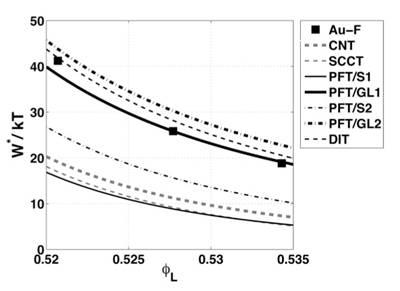
Gyula Tóth1, László Gránásy2,3
1Department of Mathematical Sciences, Loughborough University, Loughborough, Leicestershire, LE11 3TU, U.K.
2Institute for Solid State Physics and Optics, Wigner Research Centre for Physics, P.O. Box 49, Budapest H-1525, Hungary
3BCAST, Brunel University, Uxbridge, Middlesex, UB8 3PH, United Kingdom
The hard-sphere system is the best known fluid that crystallizes: the solid-liquid interfacial free energy, the equations of state, and the height of the nucleation barrier are known accurately, offering a unique possibility for a quantitative validation of nucleation theories. A recent significant downward revision of the interfacial free energy from 0.61kT/s^2 to 0.56 kT/s^2 [Davidchack, R.; Morris, J. R.; Laird, B. B. J. Chem. Phys. 125, 094710 (2006)] necessitates a re-evaluation of theoretical approaches to crystal nucleation. This has been carried out for the droplet model of the classical nucleation theory (CNT), the self-consistent classical theory (SCCT), a phenomenological diffuse interface theory (DIT), and single- and two-field variants of the phase field theory that rely on either the usual double-well and interpolation functions (PFT/S1 and PFT/S2, respectively) or on a Ginzburg-Landau expanded free energy that reflects the crystal symmetries (PFT/GL1 and PFT/GL2). We find that the PFT/GL1, PFT/GL2, and DIT models predict fairly accurately the height of the nucleation barrier known from Monte Carlo simulations in the volume fraction range of 0.52 < f < 0.54, whereas the CNT, SCCT, PFT/S1, and PFT/S2 models underestimate it significantly.


